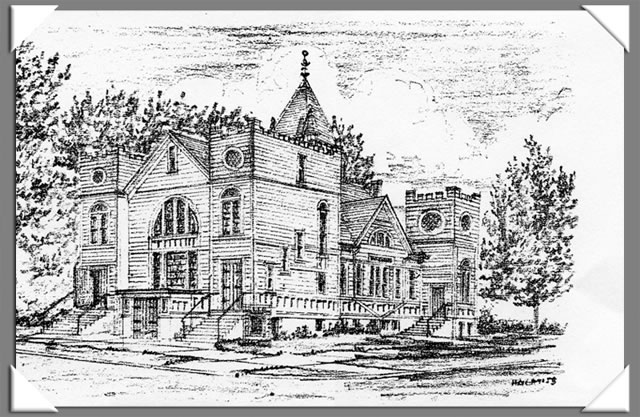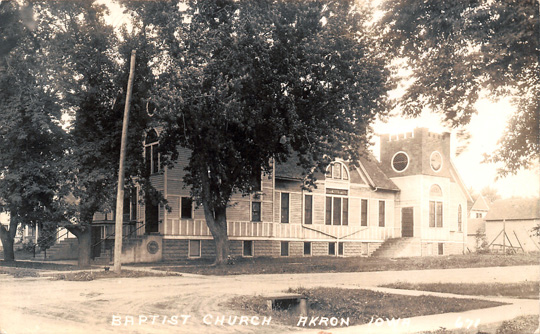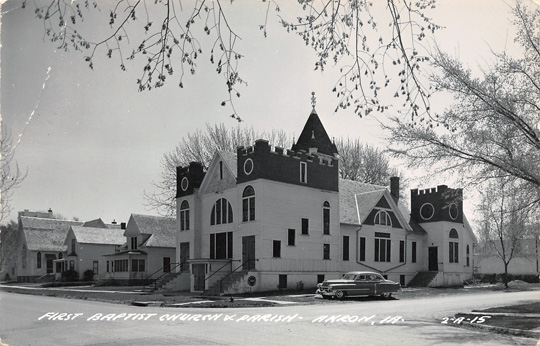
Pastors of the First Baptist Church, Akron, Iowa 1871-1979
History of the Church In 1870, Mrs. William Tremain organized a Baptist Sunday school in the Ross school house, three miles north of Akron near LeRoy in Dakota Territory. Its first superintendent was Mrs. Schooler. On March 20, 1871, Rev. George Freeman, Agent General of the American Baptist Home Missions Society, on his way from Elk Point, D.T. to Sioux Falls, D.T., preached ‘according to appointment’ in the Ross school. This was the first sermon by a Baptist clergyman in Sioux Valley. So much interest was manifested that Rev. Mr. Freeman remained the rest of the week. The First Baptist Church of LeRoy, Dakota Territory was organized with eleven charter members on Saturday, March 25, 1871. On the following day a number of converts were baptized in the nearby Big Sioux River, and the first communion was administered. The Charter Members of there church were: In 1872, E.W. Sargent gave to the Baptist congregation three lots in Portlandville, Ia., on which they might build a church building. About this time, they began to hold their meetings in Portlandville. The large Bible with the inscription “Property of the LeRoy Baptist Society” Feb. 14, 1874, is in good condition [in the early 1970s] and often used on the altar. They continued meeting in the Portland school house until January 1879, when the First Baptist Chapel was ready for occupancy. The new chapel was 24’ x 32’ and cost approximately $800. Part of this building is now used as the Primary Room (early 170s.) Originally there was a bay built on the south side of the building for the pulpit and chair. A replica of this chapel, the first built in Portlandville with a bell tower standing at the side, was used in the parade at the time Akron celebrated its Diamond Anniversary (in 1957.) The Baptist Church also took part in the pageant, depicting the Rev. Freeman coming from Elk Point to organize the LeRoy church. When the chapel was completed, there remained an indebtedness of $100. In ordinary times this would have been easily paid, but the following summer was one of drought and locusts. The farmers had little to sell, and therefore the people could pay little to the support of the church. The situation became very grave, and the Rev. Freeman returned to fill the pulpit. During these first days of the Baptist Church in Portlandville, there was a Union Sunday School, but in 1879 the Baptists organized a Sunday School of their own. In 1881, the Congregational Society was permitted to used the Baptist Chapel for worship. In 1882, the Baptists bought property on the corner of 5th and Main and several years later they built a parsonage on the lots. In 1883, the bell tower blew over, but was re-erected, a cover was built over the tower and a platform built under it. This space was used to store cordwood to be used in heating the chapel. That year the Philharmonic Society used the chapel every Tuesday evening. In 1884, the name was changed to the First Baptist Church of Akron, Iowa. In 1886, song books were purchased by the church, trees were planted around the church, and a boardwalk was built. In 1893 a baptistery was built and first used in June. In 1894 a large addition was added to the original building, costing $3000. “The floor space was 34 by 59 feet and a platform 10 by 12 feet was carved out of the north of the chapel. The high slant roof afforded a beautiful arched ceiling finished in hard wood. The church was heated by a furnace in the basement. The windows were of stained glass. The seating was of improved opera chairs. The ornamented front of the building was overtowered by a belfry situated in the northwest corner with a hall and entrance beneath. The artistic pulpit was donated to the church by Mrs. R.D. Clark. A handsome communion table was presented to the church by ladies, and the excellent cabinet organ by the Young People’s Society. A choir was organized to provide music for the church services.” In 1896, Dr. Cilley was appointed to confer with the city council about placing a street light (Kerosene) on the street corner. In 1905, the parsonage property at the corner of Fifth and Main was sold and the present parsonage was built on the lot east of the church. The following year a piano was purchased for the church. In 1907, the church lighting was improved by the installation of acetylene lighting system with mantles. That year the steel ceiling was put in the church. In 1910, the church was again enlarged and remodeled. A full basement was put under the church, an addition was built at each end of the building, and the auditorium enlarged to seat 400 persons. The balcony and special classrooms were provided. Beautiful new leaded stained glass picture windows costing $1500.00 were donated by members of the church. At this time the Hinners Pipe Organ with 518 pipes were presented to the church by Mrs. Jane Clark in memory of her husband, Dr. R.D. Clark. The cost of the addition besides the organ was $7000. In March 1946, The First Baptist Church celebrated its 75th Anniversary. Dr. Walter P. Hurlbutt, executive secretary of the Iowa Baptist Convention delivered both morning and evening sermons. During recent years, many improvements have been made in the church. The seating area under the balcony was partitioned off with windows to view the rostrum, and a loudspeaker, where mothers with small children could sit. The rostrum and sanctuary aisles were carpeted. Candelabra were memorial gifts, as were the brass altar set and collection plates. The classrooms have been paneled and carpeted, the halls and stairs have been carpeted. The kitchen was enlarged and sinks, cupboards, refrigerator, water heater, and a large stove installed. Tables for the dining room have been given as memorials. The church celebrated its Centennial date March 25, 1971, with a banquet and program for the local congregation. God has blessed the present church members with a wonderful heritage passed down from the previous generations. They were strong in their loyalty to the church, they worked together and they had an unfailing faith in God. Our prayer for the future of our church is that we and future generations may serve God, doing His will, as well as and even better than those who have gone before us. ~Source: Our Life, 1882-1982, Akron, Iowa centennial book, pgs 65,66 Photos of First Baptist Church -- Akron, Iowa
Submitted by Mr. David Shedlock--Sharing his personal Iowa Postcard Collection |
*last update 7/3/2019

